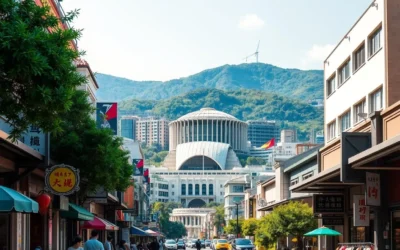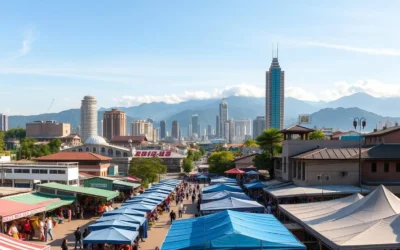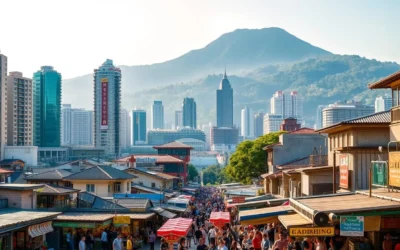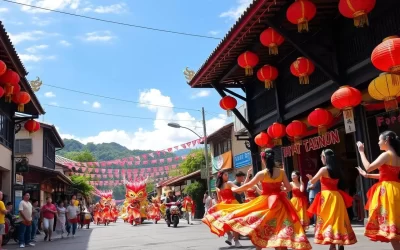✓ Accommodations✓ Flights✓ Rental Cars✓ Tours & Activities
Welcome to a journey through the vibrant linguistic tapestry of Taiwan. This island, home to over 23 million people, boasts a rich cultural heritage reflected in its diverse language system. Mandarin Chinese serves as the primary mode of communication in government, education, and media, making it the most widely used language.
However, the linguistic diversity doesn’t stop there. Taiwanese Hokkien, a dialect originating from southern China, is spoken by a significant portion of the population, especially outside the capital, Taipei. Additionally, Hakka and indigenous Formosan languages add layers of complexity to the island’s linguistic identity. These languages, though less prevalent, hold cultural significance and are integral to Taiwan’s heritage.
Historical influences, such as immigration and cultural shifts, have shaped how languages are spoken today. This unique blend of dialects and tongues makes Taiwan a fascinating case study in language evolution. Dive in to discover how these languages coexist and influence daily life on the island.
Understanding Taiwan’s Linguistic Heritage
Discover the fascinating evolution of speech in this culturally diverse region. Over centuries, waves of migration and cultural shifts have shaped how people communicate here. From early settlers to modern policies, every era has left its mark on the language landscape.

Historical Overview of Language in Taiwan
After 1945, Mandarin Chinese became the official language, a decision that transformed education and governance. Schools played a key role in spreading Mandarin, ensuring it became the primary mode of communication. However, other dialects like Taiwanese Hokkien and Hakka remained vital in daily life, especially in local communities.
Japanese colonial rule also left a lasting impact. Many older residents still speak some Japanese, a reminder of this historical period. These layers of influence create a unique blend of speech patterns that continue to evolve today.
Cultural Influences Shaping Taiwan’s Speech
In major cities like Taipei, you’ll find a mix of traditional dialects and modern speech. Immigrant groups have added to this diversity, bringing languages like Tagalog and Vietnamese into the mix. Schools and community programs also help preserve indigenous Formosan languages, though they face challenges in staying relevant.
Cultural practices and official policies work together to shape what you hear on the streets today. This dynamic interplay ensures that the linguistic heritage remains vibrant and ever-changing.
Mandarin Chinese: The Official Language of Taiwan
Mandarin Chinese stands as the cornerstone of communication in this culturally rich region. Since 1945, it has been the primary language in education, government, and daily life. Its adoption was a strategic move to unify the country and streamline communication across diverse communities.
Role in Education and Government
In schools, Mandarin is the medium of instruction, ensuring that younger generations grow up fluent in it. This focus on education has made it the most widely used language, even in homes where other dialects are spoken. The government also relies on Mandarin for official documents and public announcements, reinforcing its importance.
Over the years, policies have strengthened its position. The Mandarin Promotion Council, established in 1946, played a key role in standardizing its usage. Today, it’s not just a language but a symbol of unity in this diverse country.
Modern Adaptations and Usage
While rooted in history, Mandarin continues to evolve. Younger generations often mix it with English or other dialects, reflecting global influences. This adaptability ensures it remains relevant in a rapidly changing world.
Despite its dominance, efforts to preserve indigenous languages and dialects persist. Mandarin’s role is not to replace but to complement the rich linguistic heritage of this region. Together, they create a unique cultural identity that bridges the past and the present.
Exploring Taiwanese and Hakka: The Local Dialects
Step into the vibrant world of local dialects that shape daily life in this region. While Mandarin Chinese dominates the system of education and governance, Taiwanese (Hokkien) and Hakka remain deeply rooted in family and community interactions. These dialects are more than just ways to communicate—they are a bridge to the past and a celebration of identity.
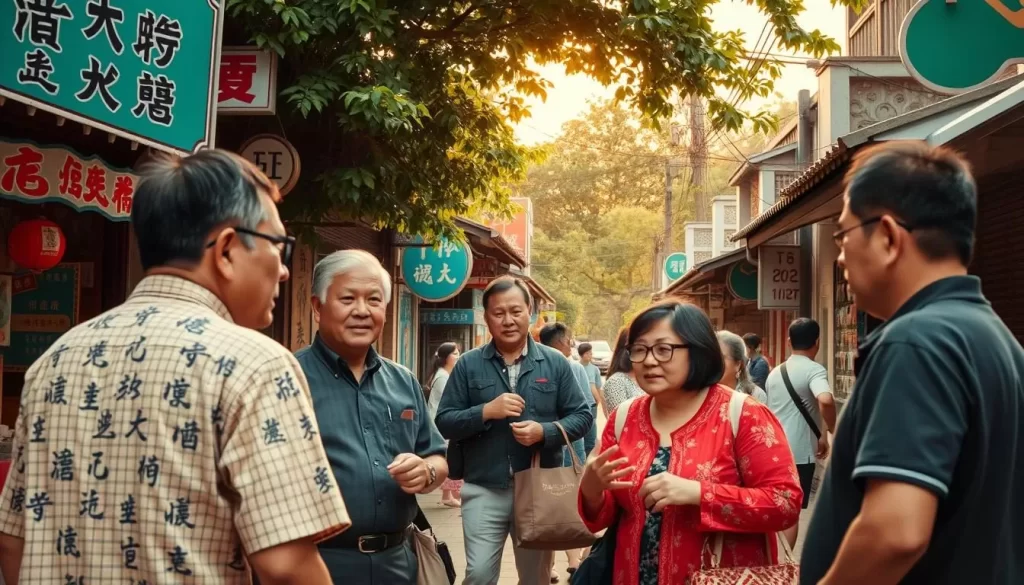
Taiwanese: The Everyday Tongue
Taiwanese, or Hokkien, is the language of the streets, markets, and homes. Over 81.9% of people speak it to some extent at home, making it a vital part of daily life. It’s common to hear it in casual conversations, especially among older generations. Younger people, however, often mix it with Mandarin Chinese, reflecting the evolving linguistic landscape.
Despite its decline among the youth, Taiwanese remains a symbol of local pride. Festivals and family gatherings often feature this dialect, keeping it alive in the hearts of many.
Hakka: Preserving an Ethnic Identity
Hakka, spoken by about 6.6% of the population, is a testament to cultural resilience. This dialect is more than just a language—it’s a marker of ethnic identity. The Hakka community actively works to preserve it through events, music, and storytelling.
In a world where dominant languages often overshadow local ones, Hakka stands as a reminder of the importance of heritage. It’s a language that connects generations and keeps traditions alive.
Community Traditions and Language Usage
Community events play a crucial role in maintaining these dialects. From temple fairs to family reunions, Taiwanese and Hakka are often the languages of choice. These gatherings are not just about communication—they’re about celebrating culture and identity.
Even in urban areas, where Mandarin Chinese is more prevalent, local dialects find their place. The Taipei MRT announcements, for example, include Taiwanese and Hakka, showcasing their importance in public life.
As the generation gap grows, efforts to preserve these dialects become more critical. Schools and community programs are stepping up to ensure that future generations can connect with their roots.
The Influence of Japanese and English on Taiwan’s Linguistic Landscape
Foreign languages have left a lasting mark on the way people communicate here. From colonial legacies to global trends, the language scene on this island is dynamic and evolving. Two languages, in particular, have shaped its linguistic identity: Japanese and English.

Legacy of Japanese Colonial Rule
Japanese colonial rule from 1895 to 1945 introduced the Japanese language to this area. Today, traces of this influence remain, especially among the older generation. Many still speak Japanese, particularly in business and cultural settings.
This historical period also left its mark on local customs and traditions. From architecture to cuisine, the influence of Japanese culture is still visible. It’s a reminder of how history shapes the way people live and communicate.
English in Education and International Business
English has become a key language for education and global commerce. Schools across the island teach English, preparing students for international opportunities. About 28.5% of the population speaks English as a second language, making it a vital skill for professionals.
In the business community, English is often the language of choice for international deals. Companies here use it to connect with global markets, enhancing their competitiveness. This trend reflects the growing importance of English in modern life.
For more insights on how English is shaping this region, check out this detailed analysis.
Both Japanese and English have played significant roles in shaping the linguistic landscape of this island. While Japanese connects the community to its past, English opens doors to the future. Together, they create a unique blend of tradition and modernity.
To explore more about the diverse languages spoken here, visit this comprehensive guide.
Preserving Indigenous and Formosan Languages in Taiwan
The rich tapestry of indigenous languages in this region faces significant challenges, yet efforts to preserve them are gaining momentum. Despite the dominance of taiwanese mandarin and taiwanese language, there is a strong cultural push to keep these unique linguistic traditions alive.

Challenges Facing Indigenous Languages
Indigenous languages are under threat due to declining speaker numbers among younger generations. Only 1.7% of the population identifies as indigenous, and many Formosan languages are endangered. The attrition rate of these languages over two generations is estimated at 15.8%, increasing to 31% over three generations.
In schools, only 37% of aboriginal students report their language is most frequently spoken at home, and just 16% claim fluency. This decline is exacerbated by the widespread use of taiwanese mandarin in education and daily life.
Revitalization and Cultural Initiatives
Both the government and community organizations are working to protect these languages. The Ministry of Education has outlined 77 tasks in its five-year plan to improve education for aborigines. Public schools in Tainan now teach the Siraya language, with one school requiring it for the first six years.
Community events and cultural programs also play a crucial role. Festivals, music, and storytelling are used to engage younger generations and encourage language learning. These efforts are vital in ensuring that indigenous languages remain a living part of the cultural heritage.
| Language | Challenges | Initiatives |
|---|---|---|
| Formosan Languages | Declining speaker numbers, endangered status | Educational programs, cultural events |
| Siraya | Historical decline, limited speakers | School curriculum, community engagement |
| Hakka | Erosion of ethnic identity | Festivals, storytelling, music |
For more insights on the preservation of indigenous languages, visit this comprehensive guide. Additionally, learn how museums are contributing to these efforts in this detailed analysis.
Taiwan: Official and widely spoken languages
Every conversation here reflects a blend of history and progress. The way people speak today is shaped by both official policies and everyday practices. This balance creates a unique linguistic identity that honors the past while embracing the future.
The Role of Official Language Policies
Mandarin Chinese, as the chinese official language, plays a central role in governance and education. It ensures unity and clarity in formal settings. However, local dialects like Taiwanese Hokkien and Hakka thrive in homes and communities, preserving cultural heritage.
This duality shows how official standards coexist with organic language use. It’s a testament to the resilience of local traditions in a modern world.
Embracing Global Influences
In today’s globalized world, English has become a key language for business and education. Many schools teach English, preparing students for international opportunities. This shift reflects the region’s openness to global trends while maintaining its linguistic roots.
Quality translation and localization services are essential in this context. They ensure that both tradition and modernity are respected in communication.
Preserving Cultural Heritage
Efforts to protect indigenous languages highlight the importance of heritage. Community events and educational programs keep these languages alive, even as Mandarin dominates daily life. This balance ensures that cultural identity remains strong in a rapidly changing world.
For more insights into Taiwan’s linguistic landscape, explore this comprehensive guide.
Conclusion
The linguistic landscape of this region is a vibrant mix of tradition and modernity. With Mandarin Taiwanese as the common language, it unites the population while allowing linguistic diversity to thrive. Local dialects like Hokkien and Hakka, along with indigenous tongues, add depth to the cultural identity.
Historical influences, such as Japanese and English, have also shaped the spoken language practices. This blend creates a unique communication system that balances heritage with global trends.
Efforts to preserve indigenous languages highlight the importance of cultural roots. Programs and community initiatives ensure these traditions remain alive for future generations.
To explore more about this fascinating linguistic landscape, check out this detailed guide. It’s a journey through the rich tapestry of voices that define this region.
The above is subject to change.
Check back often to TRAVEL.COM for the latest travel tips and deals.



